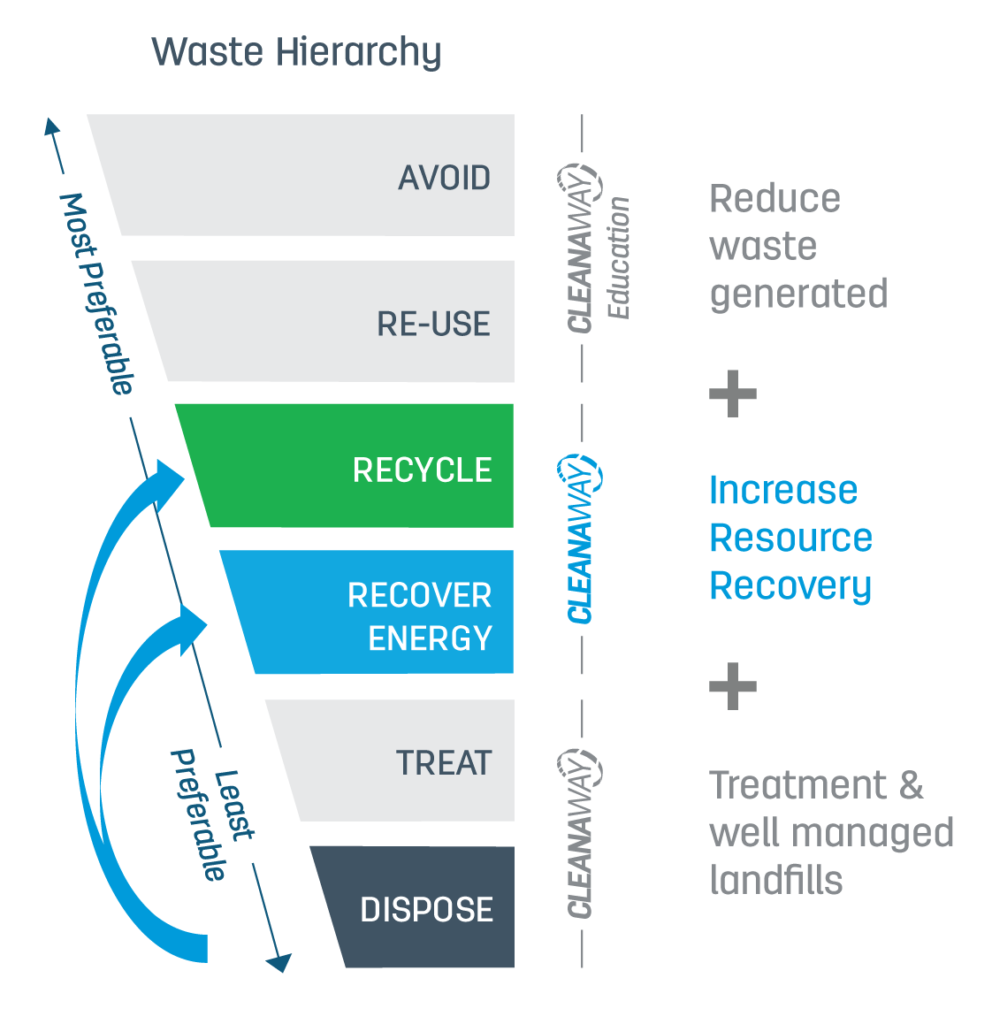When used to complement recycling, reuse and reduction initiatives, energy-from-waste can be incredibly effective for recovering resources from waste that has no other recovery pathway.
When used to complement recycling, reuse and reduction initiatives, energy-from-waste can be incredibly effective for recovering resources from waste that has no other recovery pathway.
It’s estimated that each person in Australia generates around 2.7 tonnes of waste per year. That’s 22 million tonnes of waste sent to landfill every year. Our population is growing on an average of 1.7% each year and more people result in more consumption and waste generated. This is not sustainable. Land space is finite, and contributes heavily (through production of methane which is approx. 25 times more concentrated than CO2) to our carbon footprint so a sustainable waste management strategy would seek to reduce reliance on landfill by diverting materials away from it wherever possible.
In recent times, COVID-19 has us spending more time at home and producing more waste through takeaway food, packaging from online shopping and essential single-use items such as disposable masks and test kits. People are also putting the wrong things in the wrong bin, putting even more pressure on landfill as soft plastics, food scraps and clothing contaminates quality recycling and sometimes goes to waste.
In a sustainable waste management system, the preferred strategy is to reduce the amount of rubbish produced in the first place. For the average Australian householder, this means planning your shop to avoid waste, buying only items that are necessary and avoiding single-use materials.
Making sustainable shopping choices, recycling cardboard packaging, tin cans and hard plastic in your kerbside recycling bin and composting your leftover food and green material makes a big difference to reducing waste.
And there are new recovery options emerging all the time. You can drop use specialised recycling programs for soft plastics and recycle electronic waste at your local Officeworks, with large electronics recycled through the council. So if we recovered all of these things consistently, what we’re left with is the residual waste that absolutely cannot be avoided – like nappies, material contaminated with food and personal hygiene items.
At the moment in Australia we rely on landfill for all our residual waste but there is technology being used around the world that allows us do more with this resource through energy from waste.

Energy from waste creates energy and heat from otherwise wasted resources and can be applied to produce electricity to power homes and businesses. Compared to traditional fuel sources, an energy-from-waste facility with a capacity of 500,000 tonnes per annum would reduce greenhouse gas emissions by over 390,000 tonnes of carbon dioxide equivalent each year and is a lower cost option for councils and businesses to dispose of their non-recyclable waste. Reusing the bottom ash in construction materials would allow us to divert over 95% of the residual waste “input” from landfill.
Despite the benefits, there have been understandable concerns from communities around safety and the technology used.
A common misconception is that energy from waste facilities are like incinerators from the past. In reality, energy from waste facilities are highly engineered to minimise air pollution and protect human health with cutting edge technology that has been proven in urban locations overseas for decades.
Modern facilities ensure that waste materials are completely combusted which means less polluting gases and ash remaining at the end of the process. The gases that are produced go through Flue Gas Treatment (FGT) systems that effectively ‘clean’ the gases, so that emissions that leave the facility are odourless and do not pose a risk to surrounding communities or the environment. As a bonus, the ash can even be recycled and reused in construction projects.
Just like licensed landfills, energy from waste facilities are operated under strict regulatory guidelines and located at areas specifically designed for the operation. Europe has well-established facilities that are an important part of their waste management infrastructure where they are commonly located in urban areas.
When used to complement recycling, reuse and reduction initiatives, energy-from-waste can be incredibly effective for recovering resources from waste that has no other recovery pathway.
Learn about energy-from-waste technology safety, regulations and emissions here.
Contact us to learn more about how we’re making a sustainable future possible for communities and businesses across Australia.